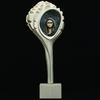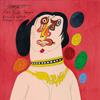American Masters of Art and Architecture in Exhibitions that Reveal Expansive Sweep of National Academy Museum Collections
- NEW YORK, New York
- /
- June 01, 2011

Reopening Exhibitions Highlight Well-Known Masterpieces and Infrequently Seen Gems of American Art.
Distinguished portraits of the early 19th century, masterpieces of the early 20th century, and contemporary works by some of today’s most compelling artists and architects will go on view on September 16, 2011 as the National Academy Museum reopens after being closed for renovations since July 2010.
The reopening exhibitions and installations of works from the permanent collection will present American art from 1820 through today and architecture since 1945. Founded in 1825, the Academy has built its collections predominantly through Diploma presentations, or works presented by artists and architects becoming members. The Academy’s collections widen the lens through which American art is viewed and appreciated. They also comprise a living history that continues to grow as artists and architects are inducted as members of the Academy.

In addition to the exhibitions of works from the permanent collection, the Academy will present Will Barnet at 100, the first New York museum retrospective of the artist and instructor who continues to make inroads in his paintings today and remains a colleague and source of inspiration to hundreds of artists, curators, and collectors.
The reopening follows renovations that will transform the visitor experience starting with the museum lobby, which will now tell the story of the Academy, and in the newly revitalized museum galleries. Additional changes will create new exhibition, teaching, and assembly space in the National Academy School.
“We are thrilled to reopen the National Academy with a series of exhibitions that tell the important and nuanced story of American art as chronicled by artists and architects over the past 186 years,” said Carmine Branagan, Director of the National Academy Museum and School. “It is also a privilege to present the first New York retrospective of Will Barnet, NA and to inaugurate new space for teaching and learning in the school. The Academy was founded in the 19th century by a group of visionary artists and architects, and we are honoring that vision in the 21st century.”

The centerpiece of the exhibitions will be An American Collection, the first rotation of a salon-style installation of approximately 100 works from the museum’s collections of over 7,000 works of art and architecture. An American Collection will present paintings by masters who charted the course of American art from 1820 through the 1970s, starting with artist, inventor, and National Academy founder Samuel F.B. Morse (William Cullen Bryant, 1828-1829). Highlights of the exhibition include works by Asher B. Durand, a leading and influential American landscape painter, among them his 1850 Landscape, which presents two artists amid an idealized landscape of the Hudson Valley. William Merritt Chase chose the socially provocative title of The Young Orphan (1884) for his tender rendering of a waif. In Hollyhocks (Among the Hollyhocks), by Frederick Carl Frieseke (by 1912), the artist demonstrates his fresh and dazzling approach to outdoor painting: "If you are looking at a mass of flowers in the sunlight out of doors you see a sparkle of spots of different colors – then paint them that way." Reginald Marsh succeeds in his goal of bringing the vitality of Peter Paul Rubens and Eugène Delacroix to a Coney Island attraction in Barrel of Fun (1943). Richard Estes’s NYC Parking Lot (1969) turns the reflections of buildings on the hoods and in the windows of cars into an urban landscape, a subject that captivated him from the late 1960s through the 1970s.
In a separate installation, The Artist Revealed: A Panorama of Great Artist Portraits, the Academy will present highlights from its extensive collection of over 1,000 portraits from the early 19th century to today. The collection comprises one of the largest and most important holdings of portraits in the United States. Highlights of the exhibition include Thomas Eakins’s only fully realized self portrait, from 1902, and works by contemporary artists Jacob Lawrence (1977), Wayne Thiebaud (1985), Chuck Close, and Susanna Coffey (1994).
Parabolas to Post-Modern: Selections of Post-War Architecture from the Academy’s Collection will highlight post-war architecture and reflect growth and change in American architecture over the last 70 years. Drawn from the Academy’s extensive but rarely seen architectural holdings, the installation will include approximately 40 drawings, renderings, models and numerous photographs by modern and contemporary architects, including Eero Saarinen (a 1962 gelatin silver print of the TWA Terminal in New York), Frank O. Gehry (The Wilton Residence Guest House, 1986), Rafael Viñoly (Tokyo International Forum, ca. 1993), Philip Johnson (The Glass House, 1949), I. M. Pei (S.I. Newhouse Communications Center, Syracuse University, 1964), Laurinda Spear (Westin New York at Times Square, New York, 1994–2002), Robert A.M. Stern (Neoclassical Farmhouse, Oldham County, Kentucky, 1983), and Cesar Pelli (World Financial Center, 1981–87).
The development of four artists and one architect will be illuminated in National Academicians: Then and Now. The installation will pair Diploma presentations with more recent work and show both the trajectory of the participants’ work and the ongoing role that Academicians are playing in the development of American art and architecture. The Academicians to be featured are architect Thom Mayne (Golf Club at Chib Prefecture, Japan, 1990) and artists Elizabeth Catlett (Fluted Head, 1991), Malcolm Morley (Leopard Panthera, 1997), Janet Fish (Untitled, 1973), and Joan Snyder (Woman with Two Babies, 1988), which is one of a group of politically motivated mixed-media works the artist created in the late 1980s in response to a series of articles concerning the plight of the children of Afghanistan, Africa, the West Bank, and Nicaragua.
An exhibition of recent Diploma presentations, Contemporary Selections: Aligning Abstraction, will focus on abstract paintings in the work of five Academicians: Bill Jensen (Luohan XI (Breath), 2005), Harriet Korman (Untitled, 2005), Melissa Meyer (A Garden for Edith, 2010), Judith Murray (Celebration, 2007), and Stephen Westfall, whose Canon (2002) is a significant transitional painting for the artist, who is best known for his colorful "broken grid" paintings.
Founded in 1825, the National Academy Museum and School is the only institution of its kind that integrates a museum, art school, and honorary association of artists and architects dedicated to creating and preserving a living history of American art. The Academy promotes American art and architecture through exhibition and education and continues to play a critical role in fostering the visual arts in America.
Exhibitions: An American Collection
Parabolas to Post-Modern: Selections of Post-War Architecture from the
Academy’s Collection
The Artist Revealed: A Panorama of Great Artist Portraits
National Academicians: Then and Now
Contemporary Selections: Aligning Abstraction
Will Barnet at 100
Dates: September 16 – December 31, 2011
Hours: Wednesday – Sunday, 11:00 AM – 6:00 PM
Note: Closed July 4th, Thanksgiving, Christmas Day and New Year’s Day
Location: National Academy Museum, 1083 Fifth Avenue, 89th/90th Streets
Admission: Adults: $12; Seniors (65+) and students with valid ID: $7
Children, members, and students of the National Academ
School: free
Contact:
Andrew DeckerAndrew Decker Communications
212 222 4688
decker06@gmail.com








![Peter Paul Rubens (Flemish, 1577–1640), After Titian (Tiziano Vecelli) (Italian [Venetian], c. 1488–1576), Rape of Europa, 1628–29. Oil on canvas, 71 7/8 x 79 3/8 in. Peter Paul Rubens (Flemish, 1577–1640), After Titian (Tiziano Vecelli) (Italian [Venetian], c. 1488–1576), Rape of Europa, 1628–29. Oil on canvas, 71 7/8 x 79 3/8 in.](/images/c/e2/2e/Jan20_Rape_of_Europa100x100_c.jpg)







